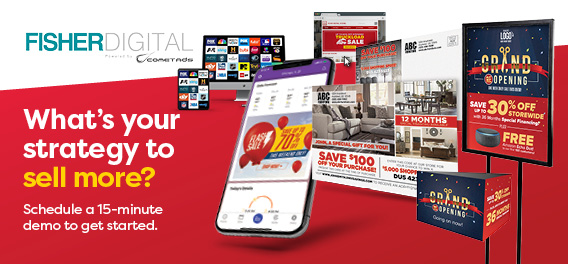Tune-Up Tips: Direct Mail Edition
July 08, 2019(Editor’s note: This is part of a monthly series about tuning up different aspects of marketing activities.)
Digital channels get a lot of attention when it comes to marketing. And while they are important, they are not the only ways to reach out to customers.
We want to delve into one of our favorite marketing channels: direct mail. The mailbox is a proven channel that can convince and convert customers.
We share 5 tune-up tips to improve your direct mail advertising and some key stats you should know about direct mail in this article.
Tune-Up Tip #1: Design to Impress
Direct mail offers a tactile channel to communicate with consumers. But it must be noticed in order for your potential customers to read it!
The average U.S. household received about 606 pieces of marketing mail in 2018, which is an average of about 2 pieces of marketing mail daily. In 2018, there were 77.3 billion pieces of marketing mail sent to 127.59 million U.S. households.
What direct mail design elements will impress? Start with a snappy combination of visuals and copy. When written text is combined with colorful visuals, consumers’ willingness to read the item increased by 80%.
Colorful visuals can include pops of color, images or other graphical elements on the direct mailer. The visuals should complement your company’s logo and your company’s other marketing materials.
Tune-Up Tip #2: Don’t Treat Direct Mail as a Standalone Channel
Relying on 1 channel to reach customers is not an effective way to share company messaging.
It can take up to 20 touchpoints to reach a customer for the first time. Further, a Canada Post neuromarketing study found that direct mail and digital channels are stronger when they are paired together. When digital advertising and direct mail were integrated into a shared marketing campaign, people paid 39% more attention to the integrated campaign than single-channel campaigns. Further, consumers had 40% higher brand recall when they received an email after getting direct mail.
Another study found that consumers spend 25% more when businesses use both direct mail and email together.
Be prepared to engage with your direct mail consumers on digital channels. Direct mail shoppers tend to interact with brands online more than non-direct mail users.
• Visited a brand’s website: 31% direct mail users vs. 19% non-users
• Liked/followed brand on social media: 22% direct mail users vs. 6% non-users
• Contacted brand: 20% direct mail users vs. 5% non-users
• Posted on social media: 19% direct mail users vs. 7% non-users
• Wrote an online review: 18% direct mail users vs. 5% non-users
Tune-Up Tip #3: Market to Millennials
Millennials like direct mail. They are also more likely than older generations to read and sort their mail.
How do Millennials feel about getting marketing mailers?
• 87% of Millennials enjoy receiving direct mail
• 84% of Millennials take time to look through their mail
• 64% of Millennials prefer to scan mail over email to look for useful information
Millennials are also more likely to engage with their mail than older generations. Millennials are 5% more likely to scan the mail, 5% more likely to organize their mail and 1% more likely to take the time to read their mail than older generations.
Plan your direct mail marketing campaign with Millennials in mind. Millennials look for brands with eco-friendly, sustainable business practices and tend to prefer value over price. For more on Millennials, see our Millennials 101 blog post.
Tune-Up Tip #4: Leverage Direct Mail to Trigger Repeat Customers
A direct mailing campaign is often a go-to channel targeting consumers who recently relocated to a new area. Indeed, we are strong proponents of launching a New Neighbor Program as a viable way to gain customer loyalty after they become your company’s new neighbor.
But that is not the only strategy. Leverage direct mail to trigger purchases from your existing customers. Three in 4 consumers discussed direct mail from a retailer that they have purchased from in the past. Almost 7 in 10 shoppers (68%) throw away mail from a brand that they have not heard of in categories they are not interested in.
What kind of direct mail campaign should you send your existing customers? The top 3 direct mail formats that customers prefer are (ranked from most preferred to least):
1) Promotional offers
2) Brochures, postcards and catalogs
3) Newsletters
Tune-Up Tip #5: Measure your success
Is direct mail a good investment?
The best way to answer this is to measure your response rate. Overall, direct mail has a high response rate, so it is likely that is a good channel.
In 2018, direct mail’s response rate was 4.9% for prospect lists, which is 2% higher than the 2.9% prospect list response rate in 2017. In 2018, the response rate for house lists was 9%, which is 3.9% higher than the 5.1% house list response rate in 2017.
How does your direct mail response rate compare to these average response rates? Look for a direct mail provider that offers trackable reporting so that you can determine whether the direct mail cost is worth the investment.
Mini-Dive: Direct Mail Overview
Direct mail impacts consumer behavior and spending. We will overview how prevalent direct mail is and how it affects consumer decision and purchasing behavior.
Prevalence
We mentioned that the average U.S. household gets 2 pieces of marketing mail daily in Tune-Up Tip #1, so direct mail is pretty common from the consumer perspective.
But just 50% of companies send direct mail vs. the 82% of companies that use email marketing. The volume of direct mail sent in the U.S. is also declining. In 2018, there were 77.3 billion pieces of marketing mail sent to U.S. households, which is a 1 billion decrease from 2017 and a 2.7 billion decrease from 2015, according to the United States Postal Service.
Consumer Decisions
Direct mail influences consumers’ spending decisions. Just 15% of consumers ignore direct mail.
Almost 8 in 10 consumers take action on direct mail while 45% of consumers take action on email immediately. Direct mail has a longer average lifespan than email—direct mail has an average life span of 17 days while email has a 2-second lifespan. That may be why direct mail is often used closer to the time of purchase.
• 67% of purchase decisions were made at home
• 79% of those who discuss purchases at home plan ahead and are more likely to have price, brand and design/style decided before making the purchase
• 61% of all direct mail recipients find it influential in making purchase decisions
• 73% use direct mail coupons when making purchases
• 57% have made purchases on direct mail offers
Considering exploring direct mailing services for your company? We are an advertising solutions provider with over 85 years of experience in the printing industry. Contact us today to get started.
Editor’s note: This is another entry in our monthly Tune-Up Tips series. Look for our next Tune-Up Tips: Photography Edition on August 19, 2019.
Read the previous entries in our Tune-Up Series:
Tune-Up Tips: Social Media Edition
Tune-Up Tips: Digital Marketing Edition

